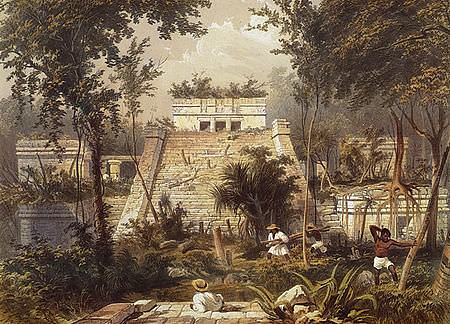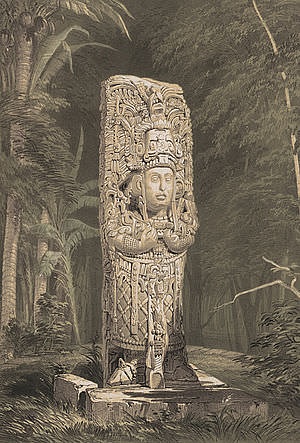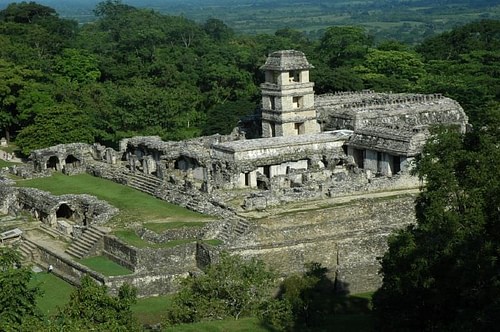The Lost Cities of the Maya the Life Art and Discoveries of Frederick Catherwood
The names of John Lloyd Stephens and Frederick Catherwood are forever linked to the Maya and Mayan studies as the two great explorers who documented the ruins from Copan in the south to Chichen Itza in the north. The stories told by Stephens in his Incidents of Travel in Central America, Chiapas and Yucatan (1841) and Incidents of Travel in Yucatan (1843) complemented by Catherwood'due south illustrations, focused international attending on the Maya civilization. Catherwood's publication of his book of lithographs Views of Aboriginal Monuments in Fundamental America, Chiapas and Yucatan (1844) furthered the world-broad interest and lifted the Maya civilization out of obscurity and into world consciousness.

Temple at Tulum by Catherwood
Every bit noted elsewhere, Stephens and Catherwood were non the kickoff explorers of the ancient Mayan sites (though they are routinely designated so). They were, nevertheless, the first to visit so many sites and, more importantly, to certificate what they institute there with precision and accurateness.
John Lloyd Stephens was born 28 Nov 1805 in Shrewsbury, New Jersey, graduated Columbia with a law caste, and good police force in New York until he was diagnosed with a throat infection. Following the advice of his doctor, Stephens left New York for a modify in climate and traveled extensively through Europe, the Mediterranean, Asia Minor, Palestine, and Egypt. These travels would result in the publication of his kickoff two books, Incidents of Travel in Egypt, Arabia Petraea and the Holy Country (1837) and Incident of Travel in Greece, Turkey, Russia and Poland (1838) both of which were immensely popular and earned Stephens the nickname `the American Traveler'.
Frederick Catherwood was born 27 February 1799 in northward London and, past his twenties, was already well known every bit an architect, creative person and traveler. He had already published his drawings of structures in Egypt, Palestine, Asia Minor, and Greece and, in 1833, was the first westerner to survey and draw the Dome of the Rock in Jerusalem. The 2 men met in London in 1836 where Catherwood's panorama `The Ruins of Jerusalem' was on display. Both men were interested in exploring the region so vividly depicted in the published accounts of Mesoamerica by earlier explorers similar Antonio del Rio and Juan Galindo and the drawings of Mayan sites by Jean-Frederic Maximilien, Comte de Waldek (Drew, 54-56).They agreed to travel together to the region at the first opportunity.
Many of the at present-famous Maya sites were unknown even to the indigenous people of the region.
Stephens was famous enough every bit a world traveler and author to accept President Van Buren appoint him Ambassador to Central America from the The states and he and Catherwood left New York for British Honduras (modernistic day Belize) on three October 1839 (Drew, 37). Though conscious of his diplomatic duties, Stephens was primarily interested in exploring the ancient ruin of Copan and then moving on to Palenque. At this time, many of the now-famous Maya sites were unknown even to the ethnic people of the region. The centuries had slowly covered the great temples and pyramids and turned them into mounds of dark-green hills. Only a few cities of the Maya were known to exist at this time, amongst them Copan, Palenque, Topoxte/Tayasal (called `Islapag' by Galindo) and the mysterious unnamed city deep in the jungle (which came to be known every bit Tikal). There were no accurate maps of the region and the two men often discovered sites through word of mouth in conversation (one instance of this beingness Catherwood'due south discovery of Quirigua). They traveled without whatever of the extensive entourage which normally accompanied 19th century explorations. They had only a guide, some men to bear equipment, and a crudely fatigued map which they had already been told was inaccurate. Nonetheless, this did non finish them from exploring the jungles of Mesoamerica in search of the ancient sites which they had heard of and read about. In his Incidents of Travel in Key America, Chiapas and Yucatan, Stephens writes of his first impressions of Copan:
Diverging from the base of operations, and working our mode through the thick woods, we came upon a square stone column, about 14 feet high and three anxiety on each side, sculptured in very bold relief, and all four sides, from the base to the top. The forepart was the figure of a man curiously and richly dressed, and the face up, evidently a portrait, solemn, stern, and well fitted to excite terror. The back was of a different pattern, dissimilar anything we had ever seen before, and the sides were covered with hieroglyphics. This our guide called an `Idol' and before it, at a altitude of three anxiety, was a large cake of stone, besides sculptured with figures and emblematical devices, which he chosen an chantry.
The sight of this unexpected monument put at residuum at once and forever, in our minds, all incertitude in regard to the graphic symbol of American antiquities, and gave us the balls that the objects we were in search of were interesting, non only as the remains of an unknown people, but as works of art, proving, similar newly discovered historical records, that the people who in one case occupied the Continent of America were not savages.
Stephens paid l dollars for the city of Copan and, as he says, was thought a fool by the owner for buying such useless land. He hoped to move the city en masse to a museum in New York simply constitute no ways of doing and so. He became convinced, later on simply a short time in the region, that the theories regarding Hebrew or Egyptian or Atlantean origins for the Maya ruins and glyphs were incorrect and that the structures and language were both autochthonous. Having mapped and recorded the site of Copan, they moved on through the jungle, mapping and recording sites such as nearby Quirigua and Zaculeu on their way to Palenque.

Stela D at Copan by Catherwood
Stephens and Catherwood explored each site together and and then gear up themselves to their respective tasks of writing and drawing the area. Catherwood used a device called the camera lucida which would project the image from the lens onto paper then that the artist could depict it more accurately. Information technology is because of the use of this device that Catherwood's depictions of the Mayan sites are so precise right down to the intricate curlicue work and inscriptions on the buildings (Danien, Sharer, 15). Although some have criticized his piece of work as `overly romantic', his lithographs have been used past Mayanists in the modern day in helping to restore the buildings and temples depicted in his piece of work. Catherwood does sometimes seem to take license in placing items, objects, or figures in a limerick for artistic purposes but the depictions of the buildings themselves are regarded as completely accurate. At Palenque, Catherwood contracted malaria but continued to piece of work in spite of his affliction. Stephens describes him as refusing to remainder and continuing to draw wearing gloves and netting to keep the mosquitoes away. Stephens' narrative is very descriptive in detailing the issues encountered with ticks, mosquitoes, stinging flies, bats, and mice not to mention having to hack through thick jungle and clearing the sites plenty to encounter what lay below the overgrowth.
In New York, Stephens had met a homo named Simon Peon who endemic a large tract of country in the northern Yucatan chosen Hacienda Uxmal and had provided Stephens with a rough map to detect the ruins he said were in that location. Leaving Palenque, and stopping at any site they came across or heard about, they made their way up to Uxmal. Among the sites they discovered or documented on this trip were Copan, Kabah, Merida, Palenque, Quirigua, Q'umarkaj (Utatlan), Sayil, Tonina, Topoxte, and Uxmal. Although they did not visit Tikal, Stephens mentions the white towers of the metropolis and notes their approximate location. They remained at Uxmal, documenting that site extensively, until 31 July 1840. By this time, Stephens had as well contracted Malaria and they left the Yucatan for the U.s.. The volume which was published from these travels fascinated the globe and prompted another trip to the Yucatan (this time along with Dr. Samuel Cabot) in 1841-1842 which resulted in the publication of Incidents of Travel in the Yucatan and, later, Catherwood'southward book of lithographs, Views of Ancient Monuments in Central America, Chiapas and Yucatan. On this 2nd trip they documented sites such as Ake, Chichen Itza, Dzibilnocac, Itzamal, Labna, Mayapan, Tulum, and re-visited Uxmal. They mapped, surveyed, drew and wrote about 44 distinct Maya sites all of which accept become national treasures and, some, world famous attractions.

Palace, Palenque
After the second trip both men decided to retire from travel. John Lloyd Stephens directed his energies to running the Ocean Steam Navigation Company and, after that, the Panama Railroad Company. He personally went to Panama to oversee the laying of the track and clearing of the country. Either in Panama or Bogota he is said to have suffered an blow and this, along with the toll taken by his travels, is thought to have acquired his death on 13 Oct 1852 at his dwelling house in New York at the historic period of 46. Frederick Catherwood went west after their adventures and opened upward a supply store in San Francisco, California to capitalize on the miners flocking there later on the Golden Blitz of 1849. His reputation endured as an artist, however, and his works were displayed in Manhattan salons and galleries. Returning from a trip to London aboard the South.S. Chill in 1854, Catherwood was among the over 350 passengers who died when the ship entered a thick fog depository financial institution and was rammed by the steam ship Vesta on 27 September. He was 55 years old.
The work they did lay the foundation for all future written report of the Maya civilization. They meticulously documented the sites they visited, carefully charted the courses they took, and logged the time in travel betwixt one site and the next. In reading Stephen'southward narrative, and following the maps fatigued past Catherwood, other explorers were able to expand upon their work to bring the Maya Culture to light. In 1857 Want de Charnay arrived in the region and used their work to help chart his ain exploration to more Mayan sites. Teobert Mahler also made apply of their books in his photographic journey of the sites in 1876. In 1891 Sir Alfred Percival Maudslay came to the region and dramatically changed the scope and depth of all further excavations. Maudslay is understood equally the showtime explorer to utilise a strict scientific method in excavating and examining the sites of the ancient Maya. He helped to preserve and protect many notable sites and set the standard for future expeditions and excavations. Following Maudslay, many very notable explorers made farther great advances in clearing, documenting, and photographing the Maya sites. William Holmes began work at Palenque in 1895, the same twelvemonth Teobert Maler documented Tikal, and was followed by Alfred Tozzer. In 1914, Sylvanus Griswold Morley first came to the region, best known for leading the team which excavated Chichen Itza in 1923. In 1925 Franz Flower so extensively documented Palenque that his work, similar Morley's, remains important reference textile for Mayanists in the field today. In less than ane hundred years since Stephens and Catherwood began their kickoff journeying, the Maya Culture had become recognized as 1 of the greatest produced by the ancient world.
This article has been reviewed for accuracy, reliability and adherence to academic standards prior to publication.
Source: https://www.worldhistory.org/article/419/early-explorers-of-the-maya-civilization-john-lloy/
0 Response to "The Lost Cities of the Maya the Life Art and Discoveries of Frederick Catherwood"
Post a Comment